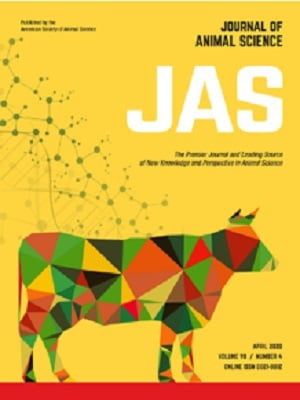Effects of copper and zinc sources and inclusion levels of copper on weanling pig performance and intestinal microbiota
Journal of Animal Science, Volume 98, Issue 5, May 2020, skaa117

Abstract
A 42-d experiment was conducted to evaluate the effect of Cu and Zn source and Cu level on pig performance, mineral status, bacterial modulation, and the presence of antimicrobial-resistant genes in isolates of Enterococcus spp. At weaning, 528 pigs (5.9 ± 0.50 kg) were allotted to 48 pens of a randomized complete block design in a 2 × 2 factorial arrangement with two Cu and Zn sources (SF: sulfate and HCl: hydroxychloride) and two Cu levels (15 and 160 mg/kg). As a challenge, the pigs were reared in dirty pens used by a previous commercial batch. Two-phase diets were offered: the pre-starter (PS) phase from day 1 to 14 and the starter phase (ST) from day 14 to 42. At days 14 and 42, pigs were individually weighed and blood samples from one pig per pen were taken. At the end of the experiment, one pig per pen was euthanized to collect the samples. Feeding high levels of Cu increased body weight (BW) from 16.6 to 17.7 kg (P < 0.001). Furthermore, average daily gain, gain to feed (G:F) ratio, average daily feed intake (ADFI), and mineral status were enhanced with Cu at 160 mg/kg (P < 0.05) compared with Cu at 15 mg/kg. There was no effect of the interaction between source × level on any of the growth performance responses except for ADFI (P = 0.004) and G:F (P = 0.029) at the end of the ST period and for G:F (P = 0.006) for entire nursery period (day 0 to 42). At the end of the ST period, pigs fed Cu at 160 mg/kg as HCl had not only higher ADFI but also lower G:F than those fed Cu as SF at 160 mg/kg. Meanwhile, for the entire nursery period, G:F did not differ between pigs fed Cu at 160 mg/kg as HCl or SF. In colonic digesta, the relative abundance of Streptococcus, Enterobacter, Escherichia, among others, decreased (P-adjust < 0.05), while Lachnospira and Roseburia tended (P-adjust < 0.10) to increase in pigs fed Cu at 160 mg/kg as HCl compared with those fed Cu SF at 160 mg/kg. An increase (P-adjust < 0.05) in Methanosphaera and Roseburia was observed in pigs fed Cu at 160 mg/kg. From colon digesta, Enterococcus spp. was isolated in 40 samples, being E. faecalis the most dominating (65%) regardless of the experimental diet. Genes of ermB (7.5%) and tetM (5%) were identified. No genes for Cu (tcrB) or vancomycin (vanA, vanB, vanC1, and vanC2) were detected. In conclusion, European Union permissible levels of Cu (160 mg/kg), of both sources, were able to increase performance, mineral status, and bacterial modulation compared with nutritional level. Different effects on growth performance, mineral tissue content, and microbial modulation were observed between Cu and Zn sources.